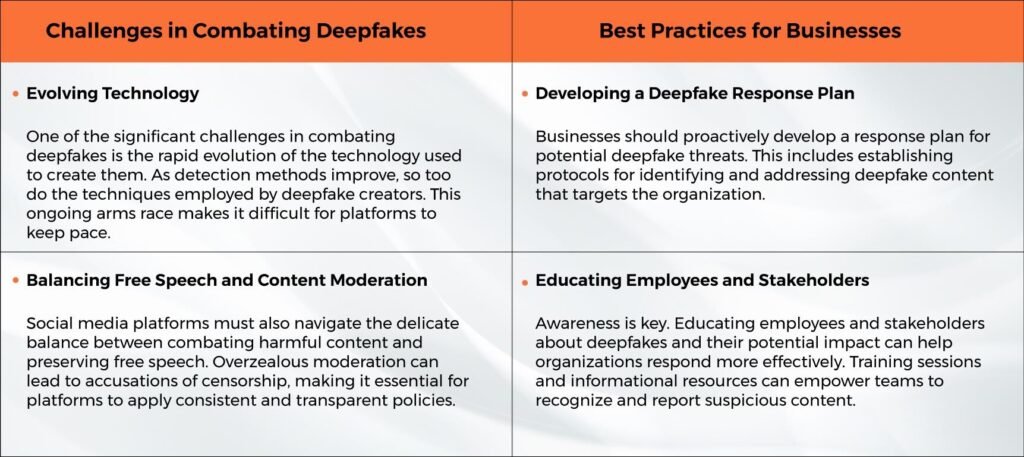Social media’s fight against deepfakes: Explore the role platforms play in countering digital misinformation.
Table of Contents
1. Understanding Deepfakes
2. The Explosion of Deepfake Content
3. The Impact of Deepfakes on Businesses
3.1 Threats Posed by Deepfakes
3.2 Legal and Financial Repercussions
4. Social Media Platforms: A Frontline Defense
4.1 Current Measures in Place
4.2 The Role of AI and Machine Learning
5. The Role of Collaboration
There is growing concern over deepfakes, which are videos and audios that are highly realistic yet fake across various industries, but perhaps more pertinent in the B2B context. These synthetic media can mislead society and create negative impacts on reputation and financial aspects. However, it is evident that social media platforms have an essential role in addressing the fake problem and enhancing the credibility of online interactions as enterprises operate in this challenging environment. This article looks at the rise of deep fakes and also explores how popular social media companies are responding to this problem.
1. Understanding Deepfakes
Deepfakes are a form of synthetic media that apply artificial intelligence and machine learning to generate hyper-realistic fake audiovisual data. This technology relies on neural networks, and particularly on generative adversarial networks (GANs), to create realistic modifications of existing media.
The first step involves the accumulation of massive data sets that include images, videos, and even voice clips of the targeted person. These datasets enable AI to capture the details of the person’s gestures, voice, and even their tone. For example, GANs are composed of two neural networks, including a generator and a discriminator. The generator thus generates fake content, and the discriminator compares it with real media. This process is carried out in a cycle where the generator generates outputs until the results are as real as the original content being emulated.
Deepfakes can accommodate a range of manipulations based on simple swaps of facial images in videos to advanced ways of forgery where a person looks and acts like doing something they never did. It can also be applied where someone’s voice is changed to say sentences he has never said. This level of realism presents some problems in differentiating between real media and fakes, which could perpetuate skepticism and distrust of digital media.
2. The Explosion of Deepfake Content
With the use of deepfake technology, recent research has exhibited a sharp rise in the production of synthetic media. Recent data show that the amount of deepfake videos has increased by more than 100% in only a year, particularly based on Deeptrace. Such a swift increase can be attributed to factors such as the availability of AI solutions and advancement of the tools used in developing deepfakes.
Based on the threats posed by deepfakes, high-profile cases have garnered much media attention. For instance, there are modified videos of popular stars that are common on social media platforms, mainly for fun but may be used to defame personalities. In political scenarios, deepfake videos have been used maliciously to control the perception of the public and sway opinions through manipulated speeches or actions made by political candidates and leaders.
It is equally important to know that the effects of such a deluge of deepfake content are far-reaching. The effects of the current deluge of deep fake content are dire. The spread of fake news may cause people to distrust different media outlets and become skeptical towards various institutions. As for the future of fakes to be used specifically for malicious purposes, these are some threats businesses should expect: damages to their brand and steep costs, legal repercussions, and losses. Given the nature of deepfakes and how they are likely to remain undetected in the future, it is important for organizations to begin understanding the technology and the implications it will have in a world that is slowly being dominated by synthetic media.
3. The Impact of Deepfakes on Businesses
3.1 Threats Posed by Deepfakes
From the perspective of risks, deep fakes impose significant threats on businesses. They can harm brand identity, erode credibility, and publish falsehoods about products, services, or even leadership. One fake video can cost a company’s reputation, customer base, and even its share price.
3.2 Legal and Financial Repercussions
It is important to note that the legal framework associated with deepfakes is still emerging. Some fakes could lead to slander or even piracy, and this puts the business in legal suit since the material produced is fake. Also, the costs of handling a deepfake crisis can run into several millions of dollars given the expenses that may include legal fees and lost revenues.
4. Social Media Platforms: A Frontline Defense
4.1 Current Measures in Place
Major social media platforms such as Facebook, Twitter, and YouTube have also identified the dangers that come with deepfakes and have deployed different mitigations. These are composed of more stringent rules for regulating the content, built-in reporting tools, and collaborations with the fact-checking organizations.
4.2 The Role of AI and Machine Learning
To identify deepfakes, several of the platforms have turned to AI and machine learning to do so. These systems look for material that has been produced with an intention of being manipulative and would therefore be helpful in responding to swathes of malicious deepfake content more efficiently. For instance, social media platforms, including Facebook, use deepfakes that are capable of identifying altered videos before they go viral.
5. The Role of Collaboration
A collective effort of social media, business organizations, and governments is vital in the fight against deep fakes due to their increasing prevalence. It can therefore be seen that no single organization can approach this problem independently, as it has elements ranging from technical detection through ethical issues to those of legal compliance. It is crucial, especially to social media sites where deepfakes are usually shared and businesses that fall victim to or could be at the receiving end of such fake videos. Through such partnerships, they can enhance the means of finding early the deepfakes, threats, information sharing, and the containing guidelines.
Companies, in their turn, provide perfect understanding of certain threats that deepfakes represent for the corresponding enterprises, brands, and consumers. By passing this information into the collaboration, they assist social media platforms to improve on the detection features and responses to brand and user protection. Also, businesses can try to make their own stakeholders aware of the risk of deepfakes, thus making the environment more secure.
Legal and ethical issues are still a concern when it comes to deepfakes, and because of this, policymakers have a very vital function for establishing policies to fight against them. Working with both the social media companies’ side and business sides makes regulations reasonable, enforceable, and protective of free speech as much as possible and attacks misinformation. The collaboration would enable the stakeholders to develop elaborate solutions that consider the issue of innovation, uphold privacy, and at the same time ensure that everyone involved has the responsibility of preventing the misuse of deepfake technology.
Parting Thoughts
Social media platforms are at the forefront of the fight against deepfakes, serving as essential gatekeepers to maintain the integrity of online communication. As the sophistication of deepfake technology rapidly evolves, these platforms face the growing challenge of detecting and mitigating manipulated content before it spreads. Their role is critical, not just in protecting users from deception but also in preserving trust across digital spaces where businesses interact with clients, stakeholders, and the public.
For companies, the stakes are equally high. Deepfakes can significantly damage brand reputation and sow confusion, eroding the trust that is central to B2B relationships. Businesses must be vigilant, ensuring they remain informed about the latest developments in deepfake technology and taking proactive steps to defend against its potential harms. By adopting a strategy that includes close collaboration with social media platforms, regular updates to security protocols, and internal training on identifying manipulated content, companies can safeguard their reputation and maintain the trust of their audience.
Explore AITechPark for top AI, IoT, Cybersecurity advancements, And amplify your reach through guest posts and link collaboration.


